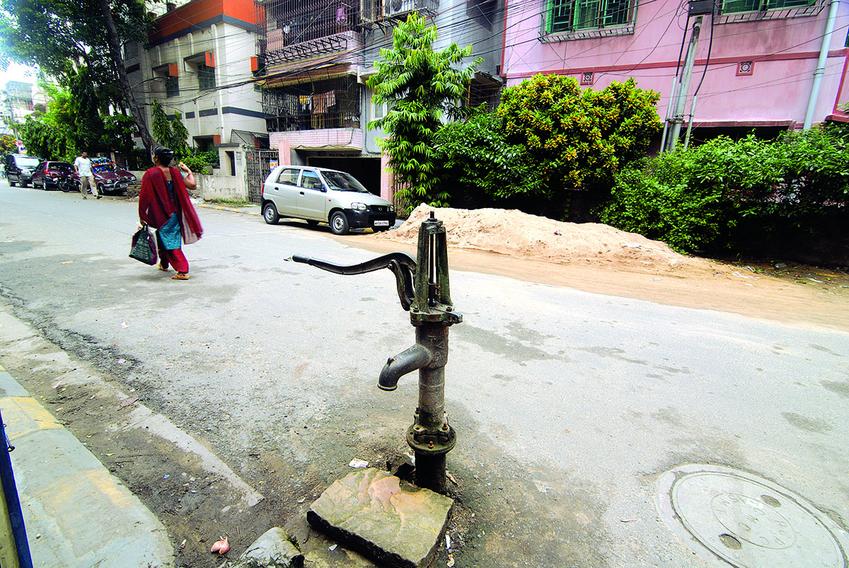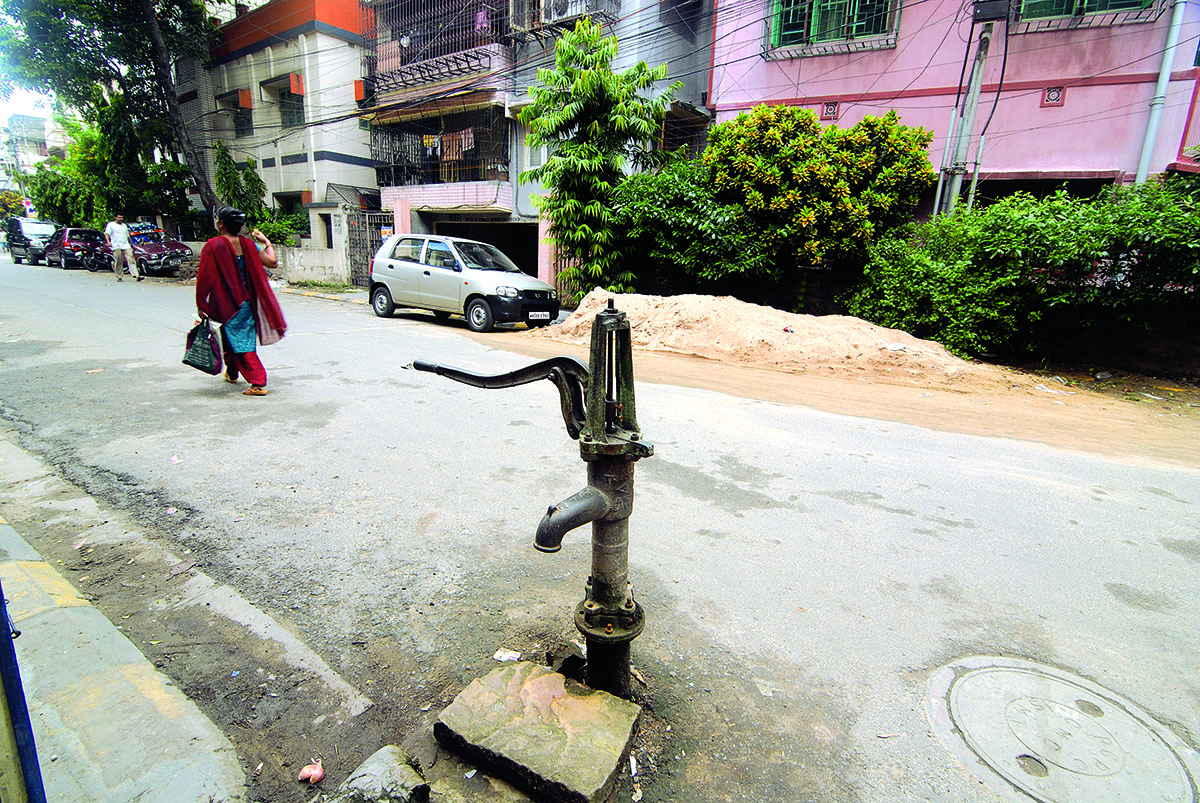
Symptoms of arsenic disease | Photo: Civil Society/ PRASANTA BiSWAS
Kolkata finally sees arsenic in its ground water
Subir Roy, Kolkata
THE risk of arsenic poisoning, faced by those who imbibe groundwater in south and southeast Kolkata, has become a major issue again and the city’s municipal authorities have gone through yet another cycle of denial and grudging acceptance of the fact that a problem exists.
The city has been sensitised to the problem mainly as a result of the pioneering work done by the School of Environmental Studies in Jadavpur University under the leadership of the school’s director of research Dipankar Chakraborti.
Arsenic has chronic toxicity but there are no known medicines to treat it. Those affected, at the least, suffer from a lack of energy and feel debilitated. Earlier it was thought arsenic could lead to skin cancer but now it is considered capable of causing virtually every type of cancer. Not much is known beyond this about the effects of arsenic, perhaps because it does not affect water sources in the world’s rich countries.
Geologically, arsenic has been washed down from the Himalayas and is prevalent in groundwater in the Ganga-Brahmaputra-Meghna basin which stretches across India and Bangladesh. The human body has its own way of fighting arsenic poisoning and a diet rich in vegetables like carrots, which the poor cannot afford, can help. So arsenic poisoning is a sort of orphan disease, affecting the poor in some of the poorest areas of the world and could deserve attention from global philanthropies like the Bill and Melinda Gates Foundation.
The latest provocation that pushed arsenic again into the headlines came earlier this year when the Kolkata Municipal corporation allowed tubewells to be bored in 10 wards of the Jadavpur Assembly constituency of south Kolkata in response to the initiative taken by the local MLA, power minister Manish Gupta, to find a solution to the water scarcity in the region. Digging tubewells needs official permission as groundwater is diminishing.
Seeing this the media extensively reported the position taken by Dr Chakraborti and a controversy erupted with the municipal corporation denying that government agencies had corroborated what Dr Chakraborti had unearthed through his school’s investigation.
Prominent among those who were unmoved by the research school’s findings was the member responsible for groundwater in the city mayor’s council, Tarak Singh, who said that Dr Chakraborti had no “authority” to conduct the tests on water samples. The mayor Shovan Chatterjee added his voice to the denial and claimed that he would take note of the risk of arsenic poisoning in the Jadavpur area only if this was established by government agencies.
Dr Chakraborti has revealed that as recently as late May, six of the 30 samples taken from Kolkata and adjoining areas examined by the school were found to contain arsenic above the safe level of less than 10 micrograms per litre set by the World Health Organisation. In fact, one sample, taken from Bikramgarh in the heart of Jadavpur, was found to contain 190 micrograms per litre of arsenic, with five others in the range of 20-60.
Public outcry, however, soon led to a change of stance by the municipal corporation and in late June it decided to send a team of officials to the affected area under the guidance of Dr Chakraborti to collect samples. Tarak Singh in particular changed his position to that of having an open mind and a willingness to be guided by the findings of tests. He wanted the controversy to be resolved and now conceded that arsenic had been found in large areas of Behala, also in south Kolkata, where the affected wells had been sealed. This prompted Dr Chakraborti to comment that this was the first time in ten years that someone from the municipal corporation has responded to his warnings.
Most recently, the state’s water investigation directorate has in a report submitted to the Kolkata Municipal corporation said that of the 96 water samples collected from Kolkata and adjoining municipalities, 13 have been found to contain arsenic above the safe level. Of these, eight are from the Kolkata municipal area. Mayor Chatterjee has denied such a report being received though Tarak Singh has admitted that tubewell water from different Kolkata municipal areas has been found to contain arsenic above the safe level.
Dr Chakraborti, who began working on the subject in 1982, recalls that for 13 years, till 1995, the system was in denial and his warnings went unheeded. Since he had secured grants from all over the world for his work, Left Front politicians, then in power, had called him an agent of western multinationals and threatened to put him in jail.
 A tubewell with arsenic in its water at lake Gardens in kolkata | Photo: PRASANTA BiSWAS
A tubewell with arsenic in its water at lake Gardens in kolkata | Photo: PRASANTA BiSWAS
He has a multilayered solution to the problem. Water from all the tubewells in the area should be tested and fresh tubewells sunk only in areas which show no trace of arsenic. Then the boring should go up to roughly 500 ft to the third aquifer to get to arsenic free water. Thereafter the water extracted should be tested every three months and the local people trained to keep a vigil over both water quality and report first symptoms that may appear in anybody affected.
Arsenic toxicity was first detected in a Jadavpur resident in 1993 and the first arsenic patient with cancer also detected in the same year. In 2001 the Kolkata Municipal corporation admitted to the presence of arsenic in the city’s drinking water. In 2003 tubewells were sealed in the campus of the state’s foremost public hospital, SSKM, presumably because arsenic was detected in their water. In this process of denial and acceptance municipal corporation sources again accepted the presence of arsenic in the city’s drinking water in 2007.
The history of denial and subsequent turnaround is as long as it is star studded. In 1999, the current chief minister of West Bengal Mamata Banerjee, then union railway minister, complained to the Planning commission that the West Bengal government was not taking proper care of arsenic contamination in the affected districts of the state. After much controversy in 2001 the then minister for water investigation admitted to arsenic contamination in West Bengal. Subrata Mukherjee, who as mayor in 2000 denied that there was arsenic in groundwater imbibed in Kolkata, has now, in his avatar as the state’s minister for public health engineering, come around to the view that there is arsenic in water in Jadavpur.
Till 2010 from over 5000 water samples collected from the Kolkata metropolitan area and tested by the school, 12.7 per cent have been found to contain arsenic of over the 10 microgram per litre norm. Research done by a scholar at the school put water from 18 per cent of Kolkata municipal corporation tubewells and 80 per cent of private tubewells above the safe WHO level. Water from such sources being used by residents of some up market apartment blocks has also been found to be unsafe.
The future scenario could not be more bleak. Most wards in the south and southeast of Kolkata are affected by the arsenic menace. Some tubewells which were earlier supplying good water have now been affected. Deep tubewell water is naturally safer than shallow tubewell water but some of the deep tubewells are now affected. Drinking tubewell water may not remain safe in the future.
But there is little attempt to tackle the problem with the future in mind. No water charges are levied in the city, not even for the better off. Forty per cent of piped treated river water is wasted through leaking public taps. Rainwater harvesting is mandated only for very large buildings. As the water table is going down its quality at a given level is deteriorating and it is becoming necessary to go deeper and deeper to find safe drinking water.
Comments
Currently there are no Comments. Be first to write a comment!





